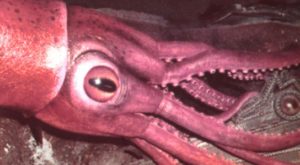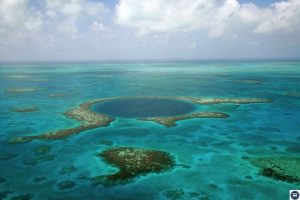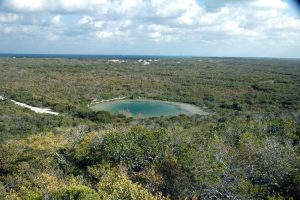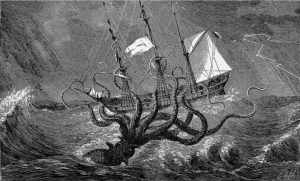Podcast: Play in new window | Download (Duration: 14:40 — 15.0MB)
It’s a bonus monster month in June, because everything is awful and learning about monsters will take our minds off the awfulness. This week let’s learn about some mysterious stories from around the world that feature huge octopus or squid!
Further watching:
River Monsters episode about the Lusca
A colossal squid, up close to that gigantic eyeball:

Blue holes in the ocean and on land:


A giant Pacific octopus swimming:

The popular image of the kraken since the 1750s:

Show transcript:
Welcome to Strange Animals Podcast. I’m your host, Kate Shaw.
Last week’s mystery bird got me thinking about how far away Halloween feels and how we haven’t really had a lot of monsters or mystery animals lately. So let’s have an extra monster month in June! We’ll start with a topic I’ve touched on in past episodes but haven’t covered in depth, three stories of GIANT OCTOPUS TYPE MONSTERS from around the world.
If you haven’t listened to episode 142, about octopuses, that ran last October, I recommend you listen to it for information about octopus biology and habits. This week we are all about the mysterious and gigantic octopuses.
Let’s jump right in with a monster from Japan, Akkorokamui. Its origins trace back to the folklore of the Ainu, a group of people who in the past mostly lived on Hokkaido, the second largest island in the country. These days they live throughout Japan. The story goes that a monster lives off the coast of Hokkaido, an octopus-like animal that in some stories is said to be 400 feet long, or over 120 meters. It’s supposed to swallow boats and whales whole. But Akkorokamui isn’t just an octopus. It has human features as well and godlike powers of healing. It’s also red, and because it’s so big, when it rises near the surface of the water, the water and even the sky look red too.
Akkorokamui is supposed to originally be from the land. A humongous red spider lived in the mountains, but one day it came down from the mountains and attacked a town, stomping down buildings as the earth shook. The villagers prayed for help, and the god of the sea heard them. He pulled the giant spider into the water where it turned into a giant octopus.
The problem with folktales, as we talked about way back in episode 17, about the Thunderbird, is that they’re not usually meant to be taken at face value. Stories impart many different kinds of information, especially in societies where writing isn’t known or isn’t known by everyone. Folktales can give warnings, record historical events, and entertain listeners, all at once. It’s possible the story of Akkorokamui is this kind of story, possibly one imparting historic information about an earthquake or tsunami that brought down a mountain and destroyed a town. That’s just a guess, though, since I don’t understand Japanese—and even if I did, the Ainu people were historically treated as inferior by the Japanese since their ancestors came from other parts of Asia, so many of their stories were never recorded properly. The Ainu people today have lost some of their historic cultural memories as they assimilated into Japanese society.
So we don’t know if Akkorokamui was once thought of as a real living animal, a spiritual entity, or just a story. There are a few reported sightings of the monster, but they’re all old and light on details. One account from the 19th century is supposedly from a Japanese fisherman who saw a monster with tentacles as big around as a grown man. It was so big that the fisherman at first thought he was just seeing reflected sunset light on the ocean. Then he came closer and realized what he was looking at—and that it was looking back at him from one enormous eye. He estimated it was something like 260 feet long, or 80 meters. Fortunately, instead of swallowing his boat, the monster sank back into the ocean.
Whether or not the folktale Akkorokamui was ever considered to be a real animal, it’s possible that some people who have seen enormous octopuses or squids have called them Akkorokamui. If you’ve listened to episode 74 about the colossal and giant squids, you may remember that both can grow over 40 feet long, or 12 meters, although the giant squid has longer arms while the colossal squid has a longer mantle in proportion to its arms. The two feeding tentacles that squids have are even longer than its arms when extended, which increases the longest measured length to 55 feet, or almost 17 meters. Both squid species are deep-sea animals that are rarely seen near the surface. But both are usually pink or red in color. A squid that big would terrify anyone, especially if they’re fishing in a small boat.
Another octopus-like sea monster is the lusca, this one from Caribbean folklore. The Caribbean Sea is part of the Atlantic Ocean outside of the Gulf of Mexico. Within the Caribbean Sea are thousands of islands, some tiny, some large, including those known collectively as the West Indies. Many reports of the lusca come from the Bahamas, specifically the so-called blue holes that dot many of the islands.
Blue holes are big round sinkholes that connect to the ocean through underground passages. Usually blue holes contain seawater, but some may have a layer of fresh water on top. Some blue holes are underwater while some are on land. The islands of the Bahamas aren’t the only places where blue holes exist. Australia, China, and Egypt all have famous blue holes, for instance, but they’re not uncommon across the world.
Blue holes form in land that contains a lot of limestone. Limestone weathers more easily than other types of rock, and most caves are formed by water percolating through limestone and slowly wearing passages through it. This is how blue holes formed too. During the Pleistocene, when the oceans were substantially lower since so much water was locked up in glaciers, blue holes formed on land, and many of them were later submerged when the sea levels rose. They can be large at the surface, but divers who try to descend into a blue hole soon discover that it pinches closed and turns into twisty passages that eventually reach the ocean, although no diver has been able to navigate so far. Many, many divers have died exploring blue holes.
Andros Island in the Bahamas has 178 blue holes on land and more than 50 in the ocean surrounding the island. It’s also the source of a lot of lusca reports.
So what does the lusca look like? Reports describe a monster that’s sharklike in the front with long octopus-like legs. It’s supposed to be huge, with an armspan of 75 feet, or 23 meters, or even more. The story goes that the tides that rise and fall in the blue holes aren’t due to tides at all but to the lusca breathing in and out.
But people really do occasionally see what they think is a lusca, and sometimes people swimming in a blue hole are dragged under and never seen again. Since blue holes don’t contain currents, it must be an animal living in the water that occasionally grabs a swimmer.
The problem is, there’s very little oxygen in the water deep within a blue hole. Fish and other animals live near the surface, but only bacteria that can thrive in low-oxygen environments live deeper. So even though the blue holes are connected to the ocean, it’s not a passage that most animals could survive. Larger animals wouldn’t be able to squeeze through the narrow openings in the rock anyway.
But maybe they don’t need to. Most blue holes have side passages carved out by freshwater streams flowing into the marine water, which causes a chemical reaction that speeds the dissolving of limestone. Some blue holes on Andros Island have side passages that extend a couple of miles, or several kilometers. It’s possible that some of these side passages also connect to the ocean, and some of them may connect to other blue holes. Most of the blue holes and side passages aren’t mapped since it’s so hard to get equipment through them.
But as far as we know, there is no monster that looks like a shark with octopus-like legs. That has to be a story to scare people, right? Maybe not. The largest octopus known to science is the giant Pacific octopus, which we talked about in episode 142. The largest ever measured had an armspan of 32 feet, or almost 10 meters. It lives in deep water and like all octopuses, it can squeeze its boneless body through quite small openings. When it swims, its arms trail behind it something like a squid’s, and it moves headfirst through the water. A big octopus has a big mantle with openings on both sides for the gills and an aperture above the siphon. The mantle of the octopus could easily be mistaken for the nose of a shark, with a glimpse of the openings assumed to be its partially open mouth. And a large octopus could easily grab a human swimming in a blue hole and drag it to its side passage lair to eat. Big octopuses eat sharks.
The giant Pacific octopus lives in the Pacific, though, not the Atlantic. If the lusca is a huge octopus, it’s probably a species unknown to science, possibly one whose mantle is more pointy in shape, more like a squid’s. That would make it resemble a shark’s snout even more.
Finally, let’s look at a monster many of us are already familiar with, the kraken. Many people think the legend of the kraken was just an exaggerated description of the giant squid. But that’s actually not the case.
The kraken is a Scandinavian monster that dates back to at least the 13th century, when a Norwegian historian wrote about it. That historian, whose name we don’t know, said it was so big that sailors took it for land while it was basking at the surface. The sailors would stop to make camp on what they thought was an island, but when they lit a campfire the kraken submerged and drowned the sailors. It could swallow ships and whales whole.
Nothing about the story mentions squid-like arms until the 1750s when a bishop called Erik Pontoppidan wrote about the kraken. Pontoppidan repeated the story of the kraken appearing island-like and then submerging, but said that it wasn’t the submerging that was so dangerous, it was the whirlpool the kraken caused as it submerged. I’d say that’s just a little bit of hair-splitting, because those sailors were in trouble either way. But Pontoppidan also said that the kraken could pull ships down into the ocean with its arms, which immediately made people think of squid and octopuses of enormous size. The idea of a stupendously large squid or octopus with its arms wrapped around a ship made its way into popular culture and remains there today.
The kraken story was probably inspired by whales, which of course were well known to Scandinavian sailors and fishers. It also might have been inspired by remote islands that are so low in the water that they’re sometimes submerged.
All that aside, could a cephalopod of enormous size actually reach out of deep water and grab the railing or masts of a ship or boat? Actually, it can’t do that, no matter how big or small. Remember that cephalopods have no skeleton, and while their arms are remarkably strong, it takes a whole lot of energy to lift a body part out of the water. We don’t notice this when swimming because our bodies are naturally buoyant especially with our lungs filled with air, and we have bones to give our bodies structure. An octopus spends most of its life supported by the water. When it comes out of the water, it stays very flat to the ground. It can only lift an arm out of the water if it can brace itself against something.
So the dramatic movie scenes where massive kraken arms suddenly shoot out of the water to seize a ship are just fantasy. But an octopus could grab onto the side of a ship with its suction cups and even heave itself onboard that way, potentially capsizing it. So that’s something fun to think about the next time you’re in a boat.
You can find Strange Animals Podcast online at strangeanimalspodcast.blubrry.net. That’s blueberry without any E’s. If you have questions, comments, or suggestions for future episodes, email us at strangeanimalspodcast@gmail.com. If you like the podcast and want to help us out, leave a rating and review on Apple Podcasts or wherever you listen to podcasts. We also have a Patreon at patreon.com/strangeanimalspodcast if you’d like to support us that way.
Thanks for listening!